Late roman republic - Study guides, Class notes & Summaries
Looking for the best study guides, study notes and summaries about Late roman republic? On this page you'll find 157 study documents about Late roman republic.
Page 4 out of 157 results
Sort by
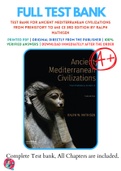
-
Test Bank For Ancient Mediterranean Civilizations From Prehistory to 640 CE 3rd Edition by Ralph Mathisen 9780190080945 Chapter 1-15 Complete Guide.
- Exam (elaborations) • 78 pages • 2023
-
- $34.18
- + learn more
Test Bank For Ancient Mediterranean Civilizations From Prehistory to 640 CE 3rd Edition by Ralph Mathisen 0945, 9, 0952, 7 1: CIVILIZATION BEFORE CIVILIZATION (2,000,000–3000 BCE) 2: MESOPOTAMIA AND THE BRONZE AGE (6000–1200 BCE) 3: EGYPT AND THE BRONZE AGE (5000–1200 BCE) 4: COASTAL CIVILIZATIONS OF THE EASTERN MEDITERRANEAN (2500–800 BCE) 5: IRON AGE EMPIRES: ASSYRIA, BABYLONIA, AND PERSIA (850–500 BCE) 6: GREECE IN THE DARK AND ARCHAIC AGES (1100–500 BCE) 7: S...
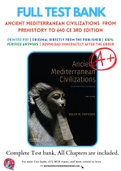
-
Test Bank for Ancient Mediterranean Civilizations From Prehistory to 640 CE 3rd Edition by Ralph W. Mathisen Chapter 1-15 Complete Guide
- Exam (elaborations) • 76 pages • 2023
-
- $34.49
- + learn more
Test Bank for Ancient Mediterranean Civilizations From Prehistory to 640 CE 3rd Edition by Ralph W. Mathisen Chapter 1-15 Complete Guide 0945, 9 1: CIVILIZATION BEFORE CIVILIZATION (2,000,000–3000 BCE) 2: MESOPOTAMIA AND THE BRONZE AGE (6000–1200 BCE) 3: EGYPT AND THE BRONZE AGE (5000–1200 BCE) 4: COASTAL CIVILIZATIONS OF THE EASTERN MEDITERRANEAN (2500–800 BCE) 5: IRON AGE EMPIRES: ASSYRIA, BABYLONIA, AND PERSIA (850–500 BCE) 6: GREECE IN THE DARK AND ARCHAIC AGE...
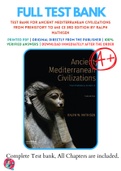
-
Test Bank For Ancient Mediterranean Civilizations From Prehistory to 640 CE 3rd Edition By Ralph W. Mathisen 9780190080945 Chapter 1-15 Complete Guide .
- Exam (elaborations) • 78 pages • 2023
-
- $26.76
- + learn more
Test Bank For Ancient Mediterranean Civilizations From Prehistory to 640 CE 3rd Edition By Ralph W. Mathisen 0945, 9 , 0952, 7 1: CIVILIZATION BEFORE CIVILIZATION (2,000,000–3000 BCE) 2: MESOPOTAMIA AND THE BRONZE AGE (6000–1200 BCE) 3: EGYPT AND THE BRONZE AGE (5000–1200 BCE) 4: COASTAL CIVILIZATIONS OF THE EASTERN MEDITERRANEAN (2500–800 BCE) 5: IRON AGE EMPIRES: ASSYRIA, BABYLONIA, AND PERSIA (850–500 BCE) 6: GREECE IN THE DARK AND ARCHAIC AGES (1100–500 BCE) ...
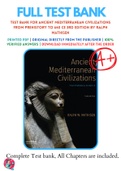
-
Test Bank For Ancient Mediterranean Civilizations From Prehistory to 640 CE 3rd Edition By Ralph W. Mathisen 9780190080945 Chapter 1-15 Complete Guide .
- Exam (elaborations) • 78 pages • 2023
-
- $33.16
- + learn more
Test Bank For Ancient Mediterranean Civilizations From Prehistory to 640 CE 3rd Edition By Ralph W. Mathisen 0945, 9 , 0952, 7 1: CIVILIZATION BEFORE CIVILIZATION (2,000,000–3000 BCE) 2: MESOPOTAMIA AND THE BRONZE AGE (6000–1200 BCE) 3: EGYPT AND THE BRONZE AGE (5000–1200 BCE) 4: COASTAL CIVILIZATIONS OF THE EASTERN MEDITERRANEAN (2500–800 BCE) 5: IRON AGE EMPIRES: ASSYRIA, BABYLONIA, AND PERSIA (850–500 BCE) 6: GREECE IN THE DARK AND ARCHAIC AGES (1100–500 BCE) ...
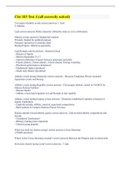
-
Clst 103 Test 4 (all correctly solved)
- Exam (elaborations) • 9 pages • 2023
-
Available in package deal
-
- $9.49
- + learn more
Two types of public events correct answers 1. Ludi 2. Munera Ludi correct answers Public character offered by state as civic celebrations Munera correct answers Gladiatorial contests Privately funded for political purpose Funerary spectacles to celebrate dead During Empire: offered as spectacles Ludi Romani correct answers - Roman festival - Honour of Jupiter - Held in September 15-17 - Annual celebration of peace between patricians and plebs - 4 horse chariot, 2 horse chari...

-
HIEU 322 Final Exam WITH COMPLETE SOLUTIONS
- Exam (elaborations) • 42 pages • 2023
-
- $16.99
- + learn more
First Triumvirate Caesar, Pompey, and Crassus Pompey Leading Roman general in the late Republic. As a statesman, he spoke poorly and awkwardly, and often fell back on silence because he could think of nothing to say. Main ambition was to be admired as Rome's greatest hero. Marcus Licinius Crassus Was of nobility, and was noted for his ambition and business savvy, particularly in the acquisition of burned property, which he would repair or rebuild for a profit. Put down...
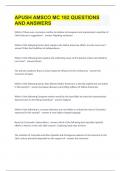
-
APUSH AMSCO MC |182 QUESTIONS AND ANSWERS|GUARANTEED SUCCESS
- Exam (elaborations) • 19 pages • 2023
-
Available in package deal
-
- $14.99
- + learn more
Which of these was a common reaction by Indians to Europeans and represented a rejection of Chief Johnson's suggestions? Migrating westward Which of the following factors best explains why Native American efforts to unite were rare? Tribes had traditions of independence Which of the following best explains the underlying cause of the Spanish actions described by Las Casas? Racism The primary audience that Las Casas hoped to influence by his writing was the monarchs of S...
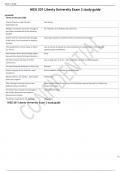
-
HIEU 201 Liberty University Exam 2 study guide Terms in this set (100) Tiberius Gracchus made himself a spokesman for land reform Plebeian concessions during the Struggle of the Orders included all of the following EXCEPT the institution of an Athenian
- Exam (elaborations) • 5 pages • 2024
- Available in package deal
-
- $7.99
- + learn more
HIEU 201 Liberty University Exam 2 study guide Terms in this set (100) Tiberius Gracchus made himself a spokesman for land reform Plebeian concessions during the Struggle of the Orders included all of the following EXCEPT the institution of an Athenian-style democracy. Despite reforms made during the Struggle of the Orders, Rome remained an oligarchy because patronage networks of wealthy families controlled the government The assassination of Julius Caesar on March 15, 44 B.C. was carr...
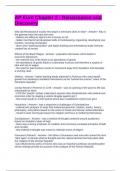
-
AP Euro Chapter 2 - Renaissance and Discovery Exam Questions and Answers
- Exam (elaborations) • 8 pages • 2024
-
Available in package deal
-
- $12.49
- + learn more
AP Euro Chapter 2 - Renaissance and Discovery Why did Renaissance society first begin in merchant cities in Italy? - Answer-- Italy is the gateway btwn the east and west - Italians are willing to spend a lot of money on art - Italian merchants had developed skills in bookkeeping, organizing, developing new markets, securing monopolies - there were "banking families" and Italian banking and international trade interests created lots of money Effects of the Black Plague - Answer-- p...

-
HUM 202 ALL Questions & ANSWERS. 100% Accurate, graded A+.
- Exam (elaborations) • 10 pages • 2023
-
Available in package deal
-
- $9.49
- + learn more
HUM 202 ALL Questions & ANSWERS. 100% Accurate, graded A+. Which of the following is a distinctive characteristic of civilization (as defined in class)? - metalurgy Regarding the Etruscans, the textbook authors state that: a) the Etruscans transformed northern and central Italian villages into towns and cities. b) the Etruscans may have migrated to central Italy from Lydia (western Turkey). c) the Etruscans were the dominant cultural and economic force during the early Roman age. d...

How did he do that? By selling his study resources on Stuvia. Try it yourself! Discover all about earning on Stuvia


